人教版七年级英语下册Unit 3 How do you get to school? 教案(5课时)
文档属性
| 名称 | 人教版七年级英语下册Unit 3 How do you get to school? 教案(5课时) | 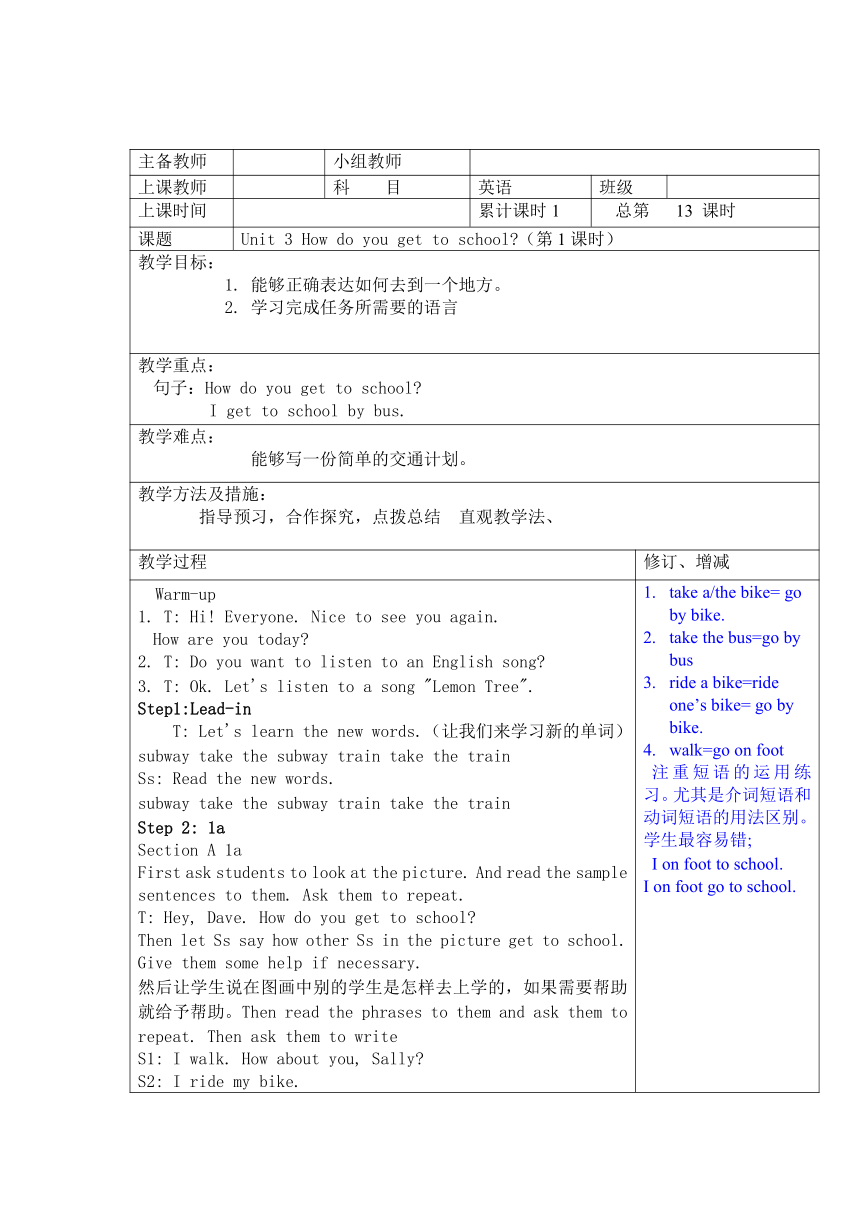 | |
| 格式 | doc | ||
| 文件大小 | 119.0KB | ||
| 资源类型 | 教案 | ||
| 版本资源 | 人教新目标(Go for it)版 | ||
| 科目 | 英语 | ||
| 更新时间 | 2022-07-03 12:40:31 | ||
图片预览

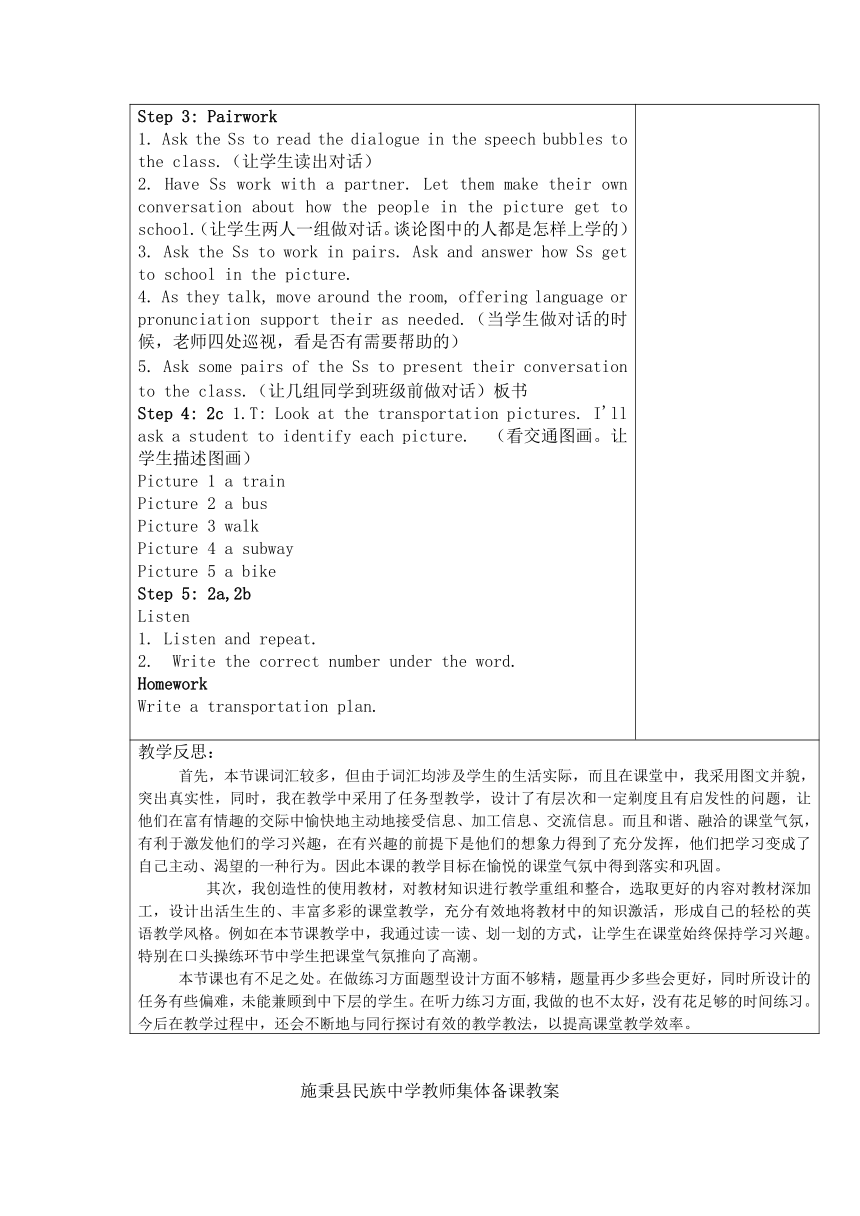
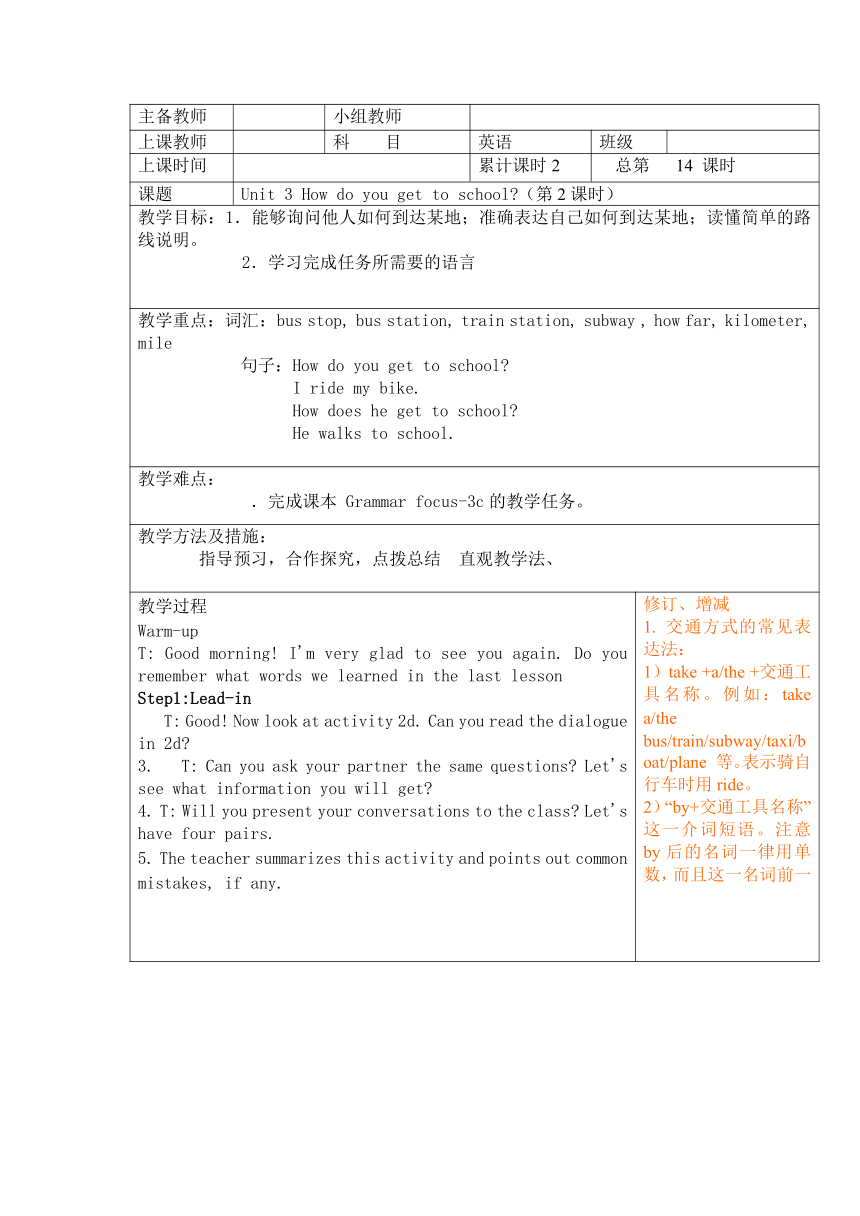
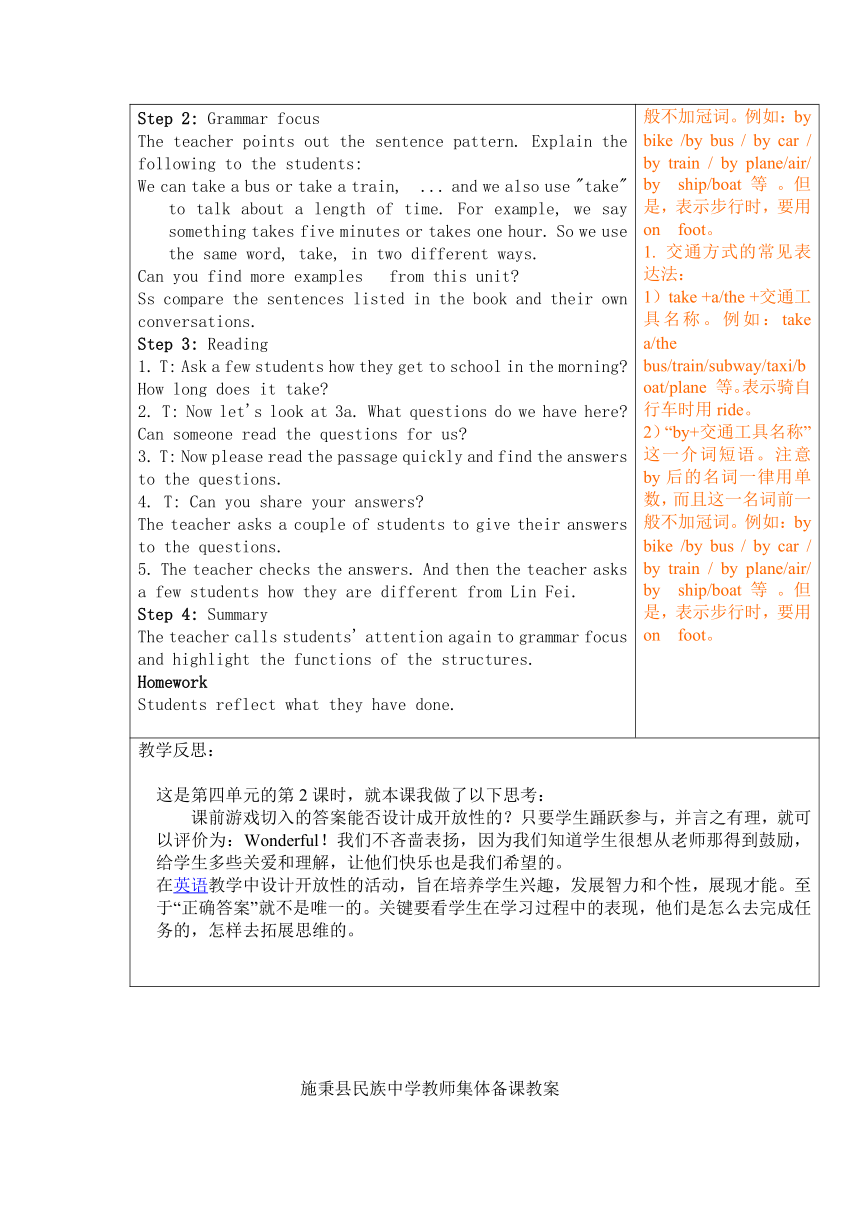
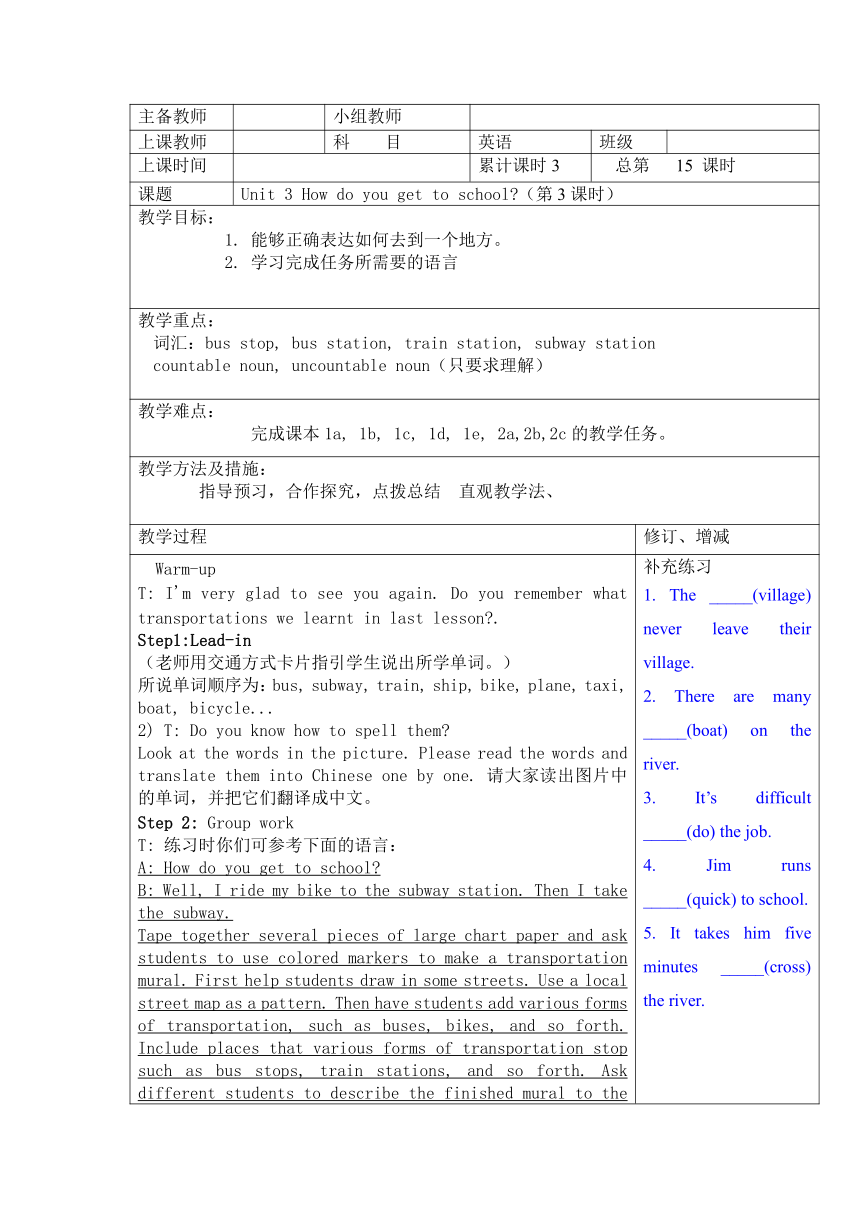
文档简介
主备教师 小组教师
上课教师 科 目 英语 班级
上课时间 累计课时1 总第 13 课时
课题 Unit 3 How do you get to school (第1课时)
教学目标:1. 能够正确表达如何去到一个地方。2. 学习完成任务所需要的语言
教学重点:句子:How do you get to school I get to school by bus.
教学难点:能够写一份简单的交通计划。
教学方法及措施: 指导预习,合作探究,点拨总结 直观教学法、
教学过程 修订、增减
Warm-up1. T: Hi! Everyone. Nice to see you again.How are you today 2. T: Do you want to listen to an English song 3. T: Ok. Let's listen to a song "Lemon Tree".Step1:Lead-in T: Let's learn the new words.(让我们来学习新的单词)subway take the subway train take the train Ss: Read the new words.subway take the subway train take the trainStep 2: 1a Section A 1aFirst ask students to look at the picture. And read the sample sentences to them. Ask them to repeat.T: Hey, Dave. How do you get to school Then let Ss say how other Ss in the picture get to school. Give them some help if necessary.然后让学生说在图画中别的学生是怎样去上学的,如果需要帮助就给予帮助。Then read the phrases to them and ask them to repeat. Then ask them to write S1: I walk. How about you, Sally S2: I ride my bike.Step 3: Pairwork1. Ask the Ss to read the dialogue in the speech bubbles to the class.(让学生读出对话)2. Have Ss work with a partner. Let them make their own conversation about how the people in the picture get to school.(让学生两人一组做对话。谈论图中的人都是怎样上学的)3. Ask the Ss to work in pairs. Ask and answer how Ss get to school in the picture.4. As they talk, move around the room, offering language or pronunciation support their as needed.(当学生做对话的时候,老师四处巡视,看是否有需要帮助的)5. Ask some pairs of the Ss to present their conversation to the class.(让几组同学到班级前做对话)板书Step 4: 2c 1.T: Look at the transportation pictures. I'll ask a student to identify each picture. (看交通图画。让学生描述图画)Picture 1 a trainPicture 2 a busPicture 3 walkPicture 4 a subwayPicture 5 a bikeStep 5: 2a,2bListen1. Listen and repeat.2. Write the correct number under the word.HomeworkWrite a transportation plan. take a/the bike= go by bike.take the bus=go by busride a bike=ride one’s bike= go by bike.walk=go on foot 注重短语的运用练习。尤其是介词短语和动词短语的用法区别。学生最容易错; I on foot to school.I on foot go to school.
教学反思:首先,本节课词汇较多,但由于词汇均涉及学生的生活实际,而且在课堂中,我采用图文并貌,突出真实性,同时,我在教学中采用了任务型教学,设计了有层次和一定剃度且有启发性的问题,让他们在富有情趣的交际中愉快地主动地接受信息、加工信息、交流信息。而且和谐、融洽的课堂气氛,有利于激发他们的学习兴趣,在有兴趣的前提下是他们的想象力得到了充分发挥,他们把学习变成了自己主动、渴望的一种行为。因此本课的教学目标在愉悦的课堂气氛中得到落实和巩固。 其次,我创造性的使用教材,对教材知识进行教学重组和整合,选取更好的内容对教材深加工,设计出活生生的、丰富多彩的课堂教学,充分有效地将教材中的知识激活,形成自己的轻松的英语教学风格。例如在本节课教学中,我通过读一读、划一划的方式,让学生在课堂始终保持学习兴趣。特别在口头操练环节中学生把课堂气氛推向了高潮。本节课也有不足之处。在做练习方面题型设计方面不够精,题量再少多些会更好,同时所设计的任务有些偏难,未能兼顾到中下层的学生。在听力练习方面,我做的也不太好,没有花足够的时间练习。今后在教学过程中,还会不断地与同行探讨有效的教学教法,以提高课堂教学效率。
施秉县民族中学教师集体备课教案
主备教师 小组教师
上课教师 科 目 英语 班级
上课时间 累计课时2 总第 14 课时
课题 Unit 3 How do you get to school (第2课时)
教学目标:1.能够询问他人如何到达某地;准确表达自己如何到达某地;读懂简单的路线说明。2.学习完成任务所需要的语言
教学重点:词汇:bus stop, bus station, train station, subway , how far, kilometer, mile句子:How do you get to school I ride my bike.How does he get to school He walks to school.
教学难点:.完成课本 Grammar focus-3c的教学任务。
教学方法及措施: 指导预习,合作探究,点拨总结 直观教学法、
教学过程Warm-upT: Good morning! I'm very glad to see you again. Do you remember what words we learned in the last lesson Step1:Lead-in T: Good! Now look at activity 2d. Can you read the dialogue in 2d 3. T: Can you ask your partner the same questions Let's see what information you will get 4. T: Will you present your conversations to the class Let's have four pairs.5. The teacher summarizes this activity and points out common mistakes, if any. 修订、增减1. 交通方式的常见表达法:1)take +a/the +交通工具名称。例如:take a/the bus/train/subway/taxi/boat/plane 等。表示骑自行车时用ride。 2)“by+交通工具名称”这一介词短语。注意by后的名词一律用单数,而且这一名词前一
Step 2: Grammar focusThe teacher points out the sentence pattern. Explain the following to the students:We can take a bus or take a train, ... and we also use "take" to talk about a length of time. For example, we say something takes five minutes or takes one hour. So we use the same word, take, in two different ways.Can you find more examples from this unit Ss compare the sentences listed in the book and their own conversations.Step 3: Reading1. T: Ask a few students how they get to school in the morning How long does it take 2. T: Now let's look at 3a. What questions do we have here Can someone read the questions for us 3. T: Now please read the passage quickly and find the answers to the questions.4. T: Can you share your answers The teacher asks a couple of students to give their answers to the questions.5. The teacher checks the answers. And then the teacher asks a few students how they are different from Lin Fei.Step 4: Summary The teacher calls students' attention again to grammar focus and highlight the functions of the structures.HomeworkStudents reflect what they have done. 般不加冠词。例如:by bike /by bus / by car / by train / by plane/air/ by ship/boat 等 。但是,表示步行时,要用on foot。1. 交通方式的常见表达法:1)take +a/the +交通工具名称。例如:take a/the bus/train/subway/taxi/boat/plane 等。表示骑自行车时用ride。 2)“by+交通工具名称”这一介词短语。注意by后的名词一律用单数,而且这一名词前一般不加冠词。例如:by bike /by bus / by car / by train / by plane/air/ by ship/boat 等 。但是,表示步行时,要用on foot。
教学反思:这是第四单元的第2课时,就本课我做了以下思考: 课前游戏切入的答案能否设计成开放性的?只要学生踊跃参与,并言之有理,就可以评价为:Wonderful!我们不吝啬表扬,因为我们知道学生很想从老师那得到鼓励,给学生多些关爱和理解,让他们快乐也是我们希望的。
在英语 ( http: / / www.21cnjy.com" \o "欢迎登陆21世纪教育网 )教学中设计开放性的活动,旨在培养学生兴趣,发展智力和个性,展现才能。至于“正确答案”就不是唯一的。关键要看学生在学习过程中的表现,他们是怎么去完成任务的,怎样去拓展思维的。
施秉县民族中学教师集体备课教案
主备教师 小组教师
上课教师 科 目 英语 班级
上课时间 累计课时3 总第 15 课时
课题 Unit 3 How do you get to school (第3课时)
教学目标:1. 能够正确表达如何去到一个地方。2. 学习完成任务所需要的语言
教学重点:词汇:bus stop, bus station, train station, subway stationcountable noun, uncountable noun(只要求理解)
教学难点:完成课本1a, 1b, 1c, 1d, 1e, 2a,2b,2c的教学任务。
教学方法及措施: 指导预习,合作探究,点拨总结 直观教学法、
教学过程 修订、增减
Warm-upT: I'm very glad to see you again. Do you remember what transportations we learnt in last lesson .Step1:Lead-in (老师用交通方式卡片指引学生说出所学单词。)所说单词顺序为:bus, subway, train, ship, bike, plane, taxi, boat, bicycle...2) T: Do you know how to spell them Look at the words in the picture. Please read the words and translate them into Chinese one by one. 请大家读出图片中的单词,并把它们翻译成中文。Step 2: Group work T: 练习时你们可参考下面的语言:A: How do you get to school B: Well, I ride my bike to the subway station. Then I take the subway.Tape together several pieces of large chart paper and ask students to use colored markers to make a transportation mural. First help students draw in some streets. Use a local street map as a pattern. Then have students add various forms of transportation, such as buses, bikes, and so forth. Include places that various forms of transportation stop such as bus stops, train stations, and so forth. Ask different students to describe the finished mural to the class.3. T: Boys and girls, would you like to show your conversations S3 and S4, please.4. Very good, thank you. Step 3: 板书同学们,我们先看一下书上的例子,我找两名同学读一下这组对话。然后我们来仿照这组对话完成自己的对话。Well done! Thank you.Now please work with you partner. You may do like the example: suppose you use two kinds of transportation to get to school (bus, train, subway, walking, bike etc.) Tell how you get to school, you may use the phrase in 1a. Then I will ask different pairs of students to present their conversations to the class.After a while... Ok, now please show me your own dialogues in order.(老师请学生作对话)Step 4: Summary 1.最后,请大家看黑板,把今天我们速学的说法再读一遍。2.After class, ask your classmate about the transportation in the chart. Find out what they like and dislike and what they usually take.Homeworkbus stop, bus station, train station, subway stationHow do you get to school How does Nina get to school Well, I ride my bike to the subway station.Then I take the subway. 补充练习1. The _____(village) never leave their village. 2. There are many _____(boat) on the river. 3. It’s difficult _____(do) the job. 4. Jim runs _____(quick) to school. 5. It takes him five minutes _____(cross) the river.
教学反思:本节课通过大量的活动,练习运用新知识,培养集体合作意识,提高语言运用能力。在真实的环境中把各种交通工具形成一个连贯完整的描述,锻炼了口语表达能力。通过小组活动灵活运用所学句型在第三人称情况下的使用,学生掌握知识较全面。
施秉县民族中学教师集体备课教案
主备教师 小组教师
上课教师 科 目 英语 班级
上课时间 累计课时4 总第 16 课时
课题 Unit 3 How do you get to school (第4课时)
教学目标:复习表达如何向别人询问道路:How do you get to school How does Nina get to school 继续学习表达采用怎样的交通方式去某地:Well, I ride my bike to the subway station.Then I take the subway.
教学重点:句子:How do you get to school I get to school by bus.
教学难点:学会转述他人怎样通过交通方式去某地。Some students also walk or ride bikes o school.了解不同国家交通方式的差别。
教学方法及措施: 指导预习,合作探究,点拨总结 直观教学法、
教学过程Warm-upT: I'm very glad to see you again. Do you remember what transportation we learnt in last lesson .Step1:Lead-in (老师用引导出交通方式句子的卡片指引学生说出所学句子。)How do you get to school Well, I ride my bike to the subway station.Then I take the subway.2) T: Do you know how to make them 电视机前的同学们你们还记得吗?Look at the picture. Please make the dialogue as last lesson.我们一起看图片。请大家仿造句子。Step 2: Practice1) Read the e-mail from your pen pal Tom in the US. Fill the blanks with the words in the box. 修订、增减1. He lives five kilometers from his grandparents’ home. (对画线部分提问)_____ _____ does he live from his grandparents’ home 2. I go to see my uncle by boat. (对画线部分提问)_____ _____ you go to see your uncle 3. My brother walks to school. (改为同义句)My brother goes to school _____ _____. 4. Many people watch TV every day. (改为同义句)_____ _____ people watch TV every day. 5. what, she, does, of, think, food, the (?)(连词成句)_________________________________________________________________
2) OK, Let's listen to it once again, this time you should follow the tape.How do students around the world get to school He gets to school by a subway.S4: Do you take a plane to school No, I don't.S5: How does your father get to work He take a taxi to work.Step 3: Practice3b. Write an e-mail toe Tom and tell him how you get to school. These questions may help you. 1. S1: number 1 choose b, bus stopS2: number 2 choose a, train stationS3: number 3 choose c, bus stationS4: number 4 choose d, subway station2. 学生小组活动Ss: Yes.S8:How do students get to Garden High School At Garden High School, most students ride their bikes to school. Many students walk to school. Some students take a bus. Other students take a car. A small number of students go to school by subway.4. Students read the passage together.How do students get to Garden High School At Garden High School, most students ride their bikes to school. Many students walk to school. Some students take a bus. Other students take a car. A small number of students go to school by subway.Step 4: Target language板书Does she like...Yes, She does.No, she doesn't.She likes ...She doesn't like
教学反思:在教学中要处理好教师的“教”和学生“学’的关系,教师应该更多地关注如何教会学生应用语言,而不仅仅向学生灌输大量的语法知识。教学过程是学生在教师的帮助和指导下掌握知识和形成技能的过程。教师应让学生在活动中发挥其主体地位,让学生自己发现问题、分析问题和坚决问题。
施秉县民族中学教师集体备课教案
主备教师 小组教师
上课教师 科 目 英语 班级
上课时间 累计课时5 总第 17 课时
课题 Unit 3 How do you get to school (第5课时)
教学目标:复习表达如何向别人询问道路:How do you get to school How does Nina get to school 继续学习表达采用怎样的交通方式去某地:Well, I ride my bike to the subway station.Then I take the subway.
教学重点:句子:How do you get to school I get to school by bus.
教学难点:学会转述他人怎样通过交通方式去某地。Some students also walk or ride bikes o school.了解不同国家交通方式的差别。
教学方法及措施: 指导预习,合作探究,点拨总结 直观教学法、
教学过程Warm-upT: I'm very glad to see you again. Do you remember what transportation we learnt in last lesson .Step1:Lead-in (老师用引导出交通方式句子的卡片指引学生说出所学句子。)How do you get to school Well, I ride my bike to the subway station.Then I take the subway.2) T: Do you know how to make them 电视机前的同学们你们还记得吗?Look at the picture. Please make the dialogue as last lesson.我们一起看图片。请大家仿造句子。Step 2: Practice1) Read the e-mail from your pen pal Tom in the US. Fill the blanks with the words in the box. 修订、增减1. He lives five kilometers from his grandparents’ home. (对画线部分提问)_____ _____ does he live from his grandparents’ home 2. I go to see my uncle by boat. (对画线部分提问)_____ _____ you go to see your uncle 3. My brother walks to school. (改为同义句)My brother goes to school _____ _____. 4. Many people watch TV every day. (改为同义句)_____ _____ people watch TV every day. 5. what, she, does, of, think, food, the (?)(连词成句)_________________________________________________________________
2) OK, Let's listen to it once again, this time you should follow the tape.How do students around the world get to school He gets to school by a subway.S4: Do you take a plane to school No, I don't.S5: How does your father get to work He take a taxi to work.Step 3: Practice3b. Write an e-mail toe Tom and tell him how you get to school. These questions may help you. 1. S1: number 1 choose b, bus stopS2: number 2 choose a, train stationS3: number 3 choose c, bus stationS4: number 4 choose d, subway station2. 学生小组活动How do students get to Garden High School At Garden High School, most students ride their bikes to school. Many students walk to school. Some students take a bus. Other students take a car. A small number of students go to school by subway.4. Students read the passage together.How do students get to Garden High School At Garden High School, most students ride their bikes to school. Many students walk to school. Some students take a bus. Other students take a car. A small number of students go to school by subway.Step 4: Target language板书Does she like...Yes, She does.No, she doesn't.She likes ...She doesn't like
教学反思:要能够熟练地使用英语这一工具,就必须拥有较高的词汇量,这是学习英语的一个重要特点,而要拥有一定的词汇量,就必须从记单词着手。记单词,这是大部分中国人都特别头痛的事,对于中学生来说,也同样如此。虽然他们正处于记忆的旺季,但如何去记才能取得佳、最快、最牢固的效果,是学生在这条刚刚连起的大桥上是否继续踏实迈步的关键,如果一步跨错,也许会有许多同学在此停步,把刚刚建起的“兴趣之桥”拆掉,而放弃对这门课的学习。为了避免这一切的发生,从开始起我就加固这已经建起的兴趣之桥,利用一切可以利用的机会教他们如何再更进一步。
主备教师 小组教师
上课教师 科 目 英语 班级
上课时间 累计课时5 总第 17 课时
课题 Unit 3 How do you get to school (第6课时)复习教案
教学目标:1.归纳本单元的重点单词和短语2.归纳本单元的重点句型和语法。
教学重点:学会运用短语
教学难点:学会转述他人怎样通过交通方式去某地。Some students also walk or ride bikes o school.了解不同国家交通方式的差别。
教学方法及措施: 归纳、讨论合作、练习
twenty二十thirty三十forty四十fifty五十sixty六十seventy七十eighty八十ninety九十hundred一百far远的minute分钟 hour小时 kilometer公里,千米 by(表示方式)乘(交通工具) take乘坐,花费时间,载某人subway地铁train火车bike自行车boat 小船bus 公共汽车car小汽车new新的drive开车live 居住;活every 每一 take a/the bus /car / boat/ train / subway/ plane/ ship / taxi/ BRT to …=go/get to…. by bus / car/ boat/ train / subway /plane/ ship / taxi/ BRT乘坐 公交车/ 小轿车/ 小船/ 火车/ 地铁/ 飞机/ 轮船/ 的士/ 快速公交去…..walk to school=go to school on foot走路去学校 ride a bike to=go to …by bike骑自行车去get to school到校 the bus ride 公共汽车车程 need an hour to get to school到校需要一小时live about five kilometers from school住的离学校五公里远一、单词短语归纳
谈论出行方式A: How do you get to school 你如何去学校?B: I ride my bike.= I get to school by bike.我骑车.A: How does she get to school 他如何去学校?B: She walks to school to school.= She gets to school on foot.她走路。 谈论花费的时间 It takes/took +某人+ 一段时间+to do sth 某人做某事花…时间A: How long does it take 花多长时间? B: It takes about 15 minutes.要花15分钟。谈论路程或距离 A: How far is it from your home to school 从你家到学校多远? B: It's three kilometers. 三公里/ It’s about ten minutes’ bus/walk. 走路/坐公交车大概10分钟的路程。询问是否用某种交通工具 A:Does Jane walk to school 简是步行去学校吗?B: No, she doesn’t. She goes by bike.不是,她骑车。A: Do they take the bus to school ?他们乘公车去上学吗?B: No, they don’t. They walk.不,他们步行。these students go on a ropeway to cross the river to school. 所以这些学生靠滑铁索来过河上学。2. There is no bridge and the river runs too quickly for boats.(河上)完全没有桥,而且河水湍急,不宜小船百度3. One 11-year-old boy crosses the river every school day.一个11岁男孩每天过河上学。4. The bus ride is never boring.坐公交车从不会无聊。5. For the students in the village, it is difficult to get to school.对村子里的学生们来说,上学困难。6. They have to cross a very big river between their school and the village. But they are not afraid. 他们得过一条横在学校和村子间的一条大河,但他们不害怕。
教学反思:英语是门用于交际的工具课。学习英语的目的之一在于将来能够在工作中熟练地运用这个工具,以口语或书面形式进行表述或表达。这就要求英语教学一开始就重视口语或书面表达能力的培养,为了在起始课中注意培养学生说、写能力,我采用了多种培养表达能力的方法。
上课教师 科 目 英语 班级
上课时间 累计课时1 总第 13 课时
课题 Unit 3 How do you get to school (第1课时)
教学目标:1. 能够正确表达如何去到一个地方。2. 学习完成任务所需要的语言
教学重点:句子:How do you get to school I get to school by bus.
教学难点:能够写一份简单的交通计划。
教学方法及措施: 指导预习,合作探究,点拨总结 直观教学法、
教学过程 修订、增减
Warm-up1. T: Hi! Everyone. Nice to see you again.How are you today 2. T: Do you want to listen to an English song 3. T: Ok. Let's listen to a song "Lemon Tree".Step1:Lead-in T: Let's learn the new words.(让我们来学习新的单词)subway take the subway train take the train Ss: Read the new words.subway take the subway train take the trainStep 2: 1a Section A 1aFirst ask students to look at the picture. And read the sample sentences to them. Ask them to repeat.T: Hey, Dave. How do you get to school Then let Ss say how other Ss in the picture get to school. Give them some help if necessary.然后让学生说在图画中别的学生是怎样去上学的,如果需要帮助就给予帮助。Then read the phrases to them and ask them to repeat. Then ask them to write S1: I walk. How about you, Sally S2: I ride my bike.Step 3: Pairwork1. Ask the Ss to read the dialogue in the speech bubbles to the class.(让学生读出对话)2. Have Ss work with a partner. Let them make their own conversation about how the people in the picture get to school.(让学生两人一组做对话。谈论图中的人都是怎样上学的)3. Ask the Ss to work in pairs. Ask and answer how Ss get to school in the picture.4. As they talk, move around the room, offering language or pronunciation support their as needed.(当学生做对话的时候,老师四处巡视,看是否有需要帮助的)5. Ask some pairs of the Ss to present their conversation to the class.(让几组同学到班级前做对话)板书Step 4: 2c 1.T: Look at the transportation pictures. I'll ask a student to identify each picture. (看交通图画。让学生描述图画)Picture 1 a trainPicture 2 a busPicture 3 walkPicture 4 a subwayPicture 5 a bikeStep 5: 2a,2bListen1. Listen and repeat.2. Write the correct number under the word.HomeworkWrite a transportation plan. take a/the bike= go by bike.take the bus=go by busride a bike=ride one’s bike= go by bike.walk=go on foot 注重短语的运用练习。尤其是介词短语和动词短语的用法区别。学生最容易错; I on foot to school.I on foot go to school.
教学反思:首先,本节课词汇较多,但由于词汇均涉及学生的生活实际,而且在课堂中,我采用图文并貌,突出真实性,同时,我在教学中采用了任务型教学,设计了有层次和一定剃度且有启发性的问题,让他们在富有情趣的交际中愉快地主动地接受信息、加工信息、交流信息。而且和谐、融洽的课堂气氛,有利于激发他们的学习兴趣,在有兴趣的前提下是他们的想象力得到了充分发挥,他们把学习变成了自己主动、渴望的一种行为。因此本课的教学目标在愉悦的课堂气氛中得到落实和巩固。 其次,我创造性的使用教材,对教材知识进行教学重组和整合,选取更好的内容对教材深加工,设计出活生生的、丰富多彩的课堂教学,充分有效地将教材中的知识激活,形成自己的轻松的英语教学风格。例如在本节课教学中,我通过读一读、划一划的方式,让学生在课堂始终保持学习兴趣。特别在口头操练环节中学生把课堂气氛推向了高潮。本节课也有不足之处。在做练习方面题型设计方面不够精,题量再少多些会更好,同时所设计的任务有些偏难,未能兼顾到中下层的学生。在听力练习方面,我做的也不太好,没有花足够的时间练习。今后在教学过程中,还会不断地与同行探讨有效的教学教法,以提高课堂教学效率。
施秉县民族中学教师集体备课教案
主备教师 小组教师
上课教师 科 目 英语 班级
上课时间 累计课时2 总第 14 课时
课题 Unit 3 How do you get to school (第2课时)
教学目标:1.能够询问他人如何到达某地;准确表达自己如何到达某地;读懂简单的路线说明。2.学习完成任务所需要的语言
教学重点:词汇:bus stop, bus station, train station, subway , how far, kilometer, mile句子:How do you get to school I ride my bike.How does he get to school He walks to school.
教学难点:.完成课本 Grammar focus-3c的教学任务。
教学方法及措施: 指导预习,合作探究,点拨总结 直观教学法、
教学过程Warm-upT: Good morning! I'm very glad to see you again. Do you remember what words we learned in the last lesson Step1:Lead-in T: Good! Now look at activity 2d. Can you read the dialogue in 2d 3. T: Can you ask your partner the same questions Let's see what information you will get 4. T: Will you present your conversations to the class Let's have four pairs.5. The teacher summarizes this activity and points out common mistakes, if any. 修订、增减1. 交通方式的常见表达法:1)take +a/the +交通工具名称。例如:take a/the bus/train/subway/taxi/boat/plane 等。表示骑自行车时用ride。 2)“by+交通工具名称”这一介词短语。注意by后的名词一律用单数,而且这一名词前一
Step 2: Grammar focusThe teacher points out the sentence pattern. Explain the following to the students:We can take a bus or take a train, ... and we also use "take" to talk about a length of time. For example, we say something takes five minutes or takes one hour. So we use the same word, take, in two different ways.Can you find more examples from this unit Ss compare the sentences listed in the book and their own conversations.Step 3: Reading1. T: Ask a few students how they get to school in the morning How long does it take 2. T: Now let's look at 3a. What questions do we have here Can someone read the questions for us 3. T: Now please read the passage quickly and find the answers to the questions.4. T: Can you share your answers The teacher asks a couple of students to give their answers to the questions.5. The teacher checks the answers. And then the teacher asks a few students how they are different from Lin Fei.Step 4: Summary The teacher calls students' attention again to grammar focus and highlight the functions of the structures.HomeworkStudents reflect what they have done. 般不加冠词。例如:by bike /by bus / by car / by train / by plane/air/ by ship/boat 等 。但是,表示步行时,要用on foot。1. 交通方式的常见表达法:1)take +a/the +交通工具名称。例如:take a/the bus/train/subway/taxi/boat/plane 等。表示骑自行车时用ride。 2)“by+交通工具名称”这一介词短语。注意by后的名词一律用单数,而且这一名词前一般不加冠词。例如:by bike /by bus / by car / by train / by plane/air/ by ship/boat 等 。但是,表示步行时,要用on foot。
教学反思:这是第四单元的第2课时,就本课我做了以下思考: 课前游戏切入的答案能否设计成开放性的?只要学生踊跃参与,并言之有理,就可以评价为:Wonderful!我们不吝啬表扬,因为我们知道学生很想从老师那得到鼓励,给学生多些关爱和理解,让他们快乐也是我们希望的。
在英语 ( http: / / www.21cnjy.com" \o "欢迎登陆21世纪教育网 )教学中设计开放性的活动,旨在培养学生兴趣,发展智力和个性,展现才能。至于“正确答案”就不是唯一的。关键要看学生在学习过程中的表现,他们是怎么去完成任务的,怎样去拓展思维的。
施秉县民族中学教师集体备课教案
主备教师 小组教师
上课教师 科 目 英语 班级
上课时间 累计课时3 总第 15 课时
课题 Unit 3 How do you get to school (第3课时)
教学目标:1. 能够正确表达如何去到一个地方。2. 学习完成任务所需要的语言
教学重点:词汇:bus stop, bus station, train station, subway stationcountable noun, uncountable noun(只要求理解)
教学难点:完成课本1a, 1b, 1c, 1d, 1e, 2a,2b,2c的教学任务。
教学方法及措施: 指导预习,合作探究,点拨总结 直观教学法、
教学过程 修订、增减
Warm-upT: I'm very glad to see you again. Do you remember what transportations we learnt in last lesson .Step1:Lead-in (老师用交通方式卡片指引学生说出所学单词。)所说单词顺序为:bus, subway, train, ship, bike, plane, taxi, boat, bicycle...2) T: Do you know how to spell them Look at the words in the picture. Please read the words and translate them into Chinese one by one. 请大家读出图片中的单词,并把它们翻译成中文。Step 2: Group work T: 练习时你们可参考下面的语言:A: How do you get to school B: Well, I ride my bike to the subway station. Then I take the subway.Tape together several pieces of large chart paper and ask students to use colored markers to make a transportation mural. First help students draw in some streets. Use a local street map as a pattern. Then have students add various forms of transportation, such as buses, bikes, and so forth. Include places that various forms of transportation stop such as bus stops, train stations, and so forth. Ask different students to describe the finished mural to the class.3. T: Boys and girls, would you like to show your conversations S3 and S4, please.4. Very good, thank you. Step 3: 板书同学们,我们先看一下书上的例子,我找两名同学读一下这组对话。然后我们来仿照这组对话完成自己的对话。Well done! Thank you.Now please work with you partner. You may do like the example: suppose you use two kinds of transportation to get to school (bus, train, subway, walking, bike etc.) Tell how you get to school, you may use the phrase in 1a. Then I will ask different pairs of students to present their conversations to the class.After a while... Ok, now please show me your own dialogues in order.(老师请学生作对话)Step 4: Summary 1.最后,请大家看黑板,把今天我们速学的说法再读一遍。2.After class, ask your classmate about the transportation in the chart. Find out what they like and dislike and what they usually take.Homeworkbus stop, bus station, train station, subway stationHow do you get to school How does Nina get to school Well, I ride my bike to the subway station.Then I take the subway. 补充练习1. The _____(village) never leave their village. 2. There are many _____(boat) on the river. 3. It’s difficult _____(do) the job. 4. Jim runs _____(quick) to school. 5. It takes him five minutes _____(cross) the river.
教学反思:本节课通过大量的活动,练习运用新知识,培养集体合作意识,提高语言运用能力。在真实的环境中把各种交通工具形成一个连贯完整的描述,锻炼了口语表达能力。通过小组活动灵活运用所学句型在第三人称情况下的使用,学生掌握知识较全面。
施秉县民族中学教师集体备课教案
主备教师 小组教师
上课教师 科 目 英语 班级
上课时间 累计课时4 总第 16 课时
课题 Unit 3 How do you get to school (第4课时)
教学目标:复习表达如何向别人询问道路:How do you get to school How does Nina get to school 继续学习表达采用怎样的交通方式去某地:Well, I ride my bike to the subway station.Then I take the subway.
教学重点:句子:How do you get to school I get to school by bus.
教学难点:学会转述他人怎样通过交通方式去某地。Some students also walk or ride bikes o school.了解不同国家交通方式的差别。
教学方法及措施: 指导预习,合作探究,点拨总结 直观教学法、
教学过程Warm-upT: I'm very glad to see you again. Do you remember what transportation we learnt in last lesson .Step1:Lead-in (老师用引导出交通方式句子的卡片指引学生说出所学句子。)How do you get to school Well, I ride my bike to the subway station.Then I take the subway.2) T: Do you know how to make them 电视机前的同学们你们还记得吗?Look at the picture. Please make the dialogue as last lesson.我们一起看图片。请大家仿造句子。Step 2: Practice1) Read the e-mail from your pen pal Tom in the US. Fill the blanks with the words in the box. 修订、增减1. He lives five kilometers from his grandparents’ home. (对画线部分提问)_____ _____ does he live from his grandparents’ home 2. I go to see my uncle by boat. (对画线部分提问)_____ _____ you go to see your uncle 3. My brother walks to school. (改为同义句)My brother goes to school _____ _____. 4. Many people watch TV every day. (改为同义句)_____ _____ people watch TV every day. 5. what, she, does, of, think, food, the (?)(连词成句)_________________________________________________________________
2) OK, Let's listen to it once again, this time you should follow the tape.How do students around the world get to school He gets to school by a subway.S4: Do you take a plane to school No, I don't.S5: How does your father get to work He take a taxi to work.Step 3: Practice3b. Write an e-mail toe Tom and tell him how you get to school. These questions may help you. 1. S1: number 1 choose b, bus stopS2: number 2 choose a, train stationS3: number 3 choose c, bus stationS4: number 4 choose d, subway station2. 学生小组活动Ss: Yes.S8:How do students get to Garden High School At Garden High School, most students ride their bikes to school. Many students walk to school. Some students take a bus. Other students take a car. A small number of students go to school by subway.4. Students read the passage together.How do students get to Garden High School At Garden High School, most students ride their bikes to school. Many students walk to school. Some students take a bus. Other students take a car. A small number of students go to school by subway.Step 4: Target language板书Does she like...Yes, She does.No, she doesn't.She likes ...She doesn't like
教学反思:在教学中要处理好教师的“教”和学生“学’的关系,教师应该更多地关注如何教会学生应用语言,而不仅仅向学生灌输大量的语法知识。教学过程是学生在教师的帮助和指导下掌握知识和形成技能的过程。教师应让学生在活动中发挥其主体地位,让学生自己发现问题、分析问题和坚决问题。
施秉县民族中学教师集体备课教案
主备教师 小组教师
上课教师 科 目 英语 班级
上课时间 累计课时5 总第 17 课时
课题 Unit 3 How do you get to school (第5课时)
教学目标:复习表达如何向别人询问道路:How do you get to school How does Nina get to school 继续学习表达采用怎样的交通方式去某地:Well, I ride my bike to the subway station.Then I take the subway.
教学重点:句子:How do you get to school I get to school by bus.
教学难点:学会转述他人怎样通过交通方式去某地。Some students also walk or ride bikes o school.了解不同国家交通方式的差别。
教学方法及措施: 指导预习,合作探究,点拨总结 直观教学法、
教学过程Warm-upT: I'm very glad to see you again. Do you remember what transportation we learnt in last lesson .Step1:Lead-in (老师用引导出交通方式句子的卡片指引学生说出所学句子。)How do you get to school Well, I ride my bike to the subway station.Then I take the subway.2) T: Do you know how to make them 电视机前的同学们你们还记得吗?Look at the picture. Please make the dialogue as last lesson.我们一起看图片。请大家仿造句子。Step 2: Practice1) Read the e-mail from your pen pal Tom in the US. Fill the blanks with the words in the box. 修订、增减1. He lives five kilometers from his grandparents’ home. (对画线部分提问)_____ _____ does he live from his grandparents’ home 2. I go to see my uncle by boat. (对画线部分提问)_____ _____ you go to see your uncle 3. My brother walks to school. (改为同义句)My brother goes to school _____ _____. 4. Many people watch TV every day. (改为同义句)_____ _____ people watch TV every day. 5. what, she, does, of, think, food, the (?)(连词成句)_________________________________________________________________
2) OK, Let's listen to it once again, this time you should follow the tape.How do students around the world get to school He gets to school by a subway.S4: Do you take a plane to school No, I don't.S5: How does your father get to work He take a taxi to work.Step 3: Practice3b. Write an e-mail toe Tom and tell him how you get to school. These questions may help you. 1. S1: number 1 choose b, bus stopS2: number 2 choose a, train stationS3: number 3 choose c, bus stationS4: number 4 choose d, subway station2. 学生小组活动How do students get to Garden High School At Garden High School, most students ride their bikes to school. Many students walk to school. Some students take a bus. Other students take a car. A small number of students go to school by subway.4. Students read the passage together.How do students get to Garden High School At Garden High School, most students ride their bikes to school. Many students walk to school. Some students take a bus. Other students take a car. A small number of students go to school by subway.Step 4: Target language板书Does she like...Yes, She does.No, she doesn't.She likes ...She doesn't like
教学反思:要能够熟练地使用英语这一工具,就必须拥有较高的词汇量,这是学习英语的一个重要特点,而要拥有一定的词汇量,就必须从记单词着手。记单词,这是大部分中国人都特别头痛的事,对于中学生来说,也同样如此。虽然他们正处于记忆的旺季,但如何去记才能取得佳、最快、最牢固的效果,是学生在这条刚刚连起的大桥上是否继续踏实迈步的关键,如果一步跨错,也许会有许多同学在此停步,把刚刚建起的“兴趣之桥”拆掉,而放弃对这门课的学习。为了避免这一切的发生,从开始起我就加固这已经建起的兴趣之桥,利用一切可以利用的机会教他们如何再更进一步。
主备教师 小组教师
上课教师 科 目 英语 班级
上课时间 累计课时5 总第 17 课时
课题 Unit 3 How do you get to school (第6课时)复习教案
教学目标:1.归纳本单元的重点单词和短语2.归纳本单元的重点句型和语法。
教学重点:学会运用短语
教学难点:学会转述他人怎样通过交通方式去某地。Some students also walk or ride bikes o school.了解不同国家交通方式的差别。
教学方法及措施: 归纳、讨论合作、练习
twenty二十thirty三十forty四十fifty五十sixty六十seventy七十eighty八十ninety九十hundred一百far远的minute分钟 hour小时 kilometer公里,千米 by(表示方式)乘(交通工具) take乘坐,花费时间,载某人subway地铁train火车bike自行车boat 小船bus 公共汽车car小汽车new新的drive开车live 居住;活every 每一 take a/the bus /car / boat/ train / subway/ plane/ ship / taxi/ BRT to …=go/get to…. by bus / car/ boat/ train / subway /plane/ ship / taxi/ BRT乘坐 公交车/ 小轿车/ 小船/ 火车/ 地铁/ 飞机/ 轮船/ 的士/ 快速公交去…..walk to school=go to school on foot走路去学校 ride a bike to=go to …by bike骑自行车去get to school到校 the bus ride 公共汽车车程 need an hour to get to school到校需要一小时live about five kilometers from school住的离学校五公里远一、单词短语归纳
谈论出行方式A: How do you get to school 你如何去学校?B: I ride my bike.= I get to school by bike.我骑车.A: How does she get to school 他如何去学校?B: She walks to school to school.= She gets to school on foot.她走路。 谈论花费的时间 It takes/took +某人+ 一段时间+to do sth 某人做某事花…时间A: How long does it take 花多长时间? B: It takes about 15 minutes.要花15分钟。谈论路程或距离 A: How far is it from your home to school 从你家到学校多远? B: It's three kilometers. 三公里/ It’s about ten minutes’ bus/walk. 走路/坐公交车大概10分钟的路程。询问是否用某种交通工具 A:Does Jane walk to school 简是步行去学校吗?B: No, she doesn’t. She goes by bike.不是,她骑车。A: Do they take the bus to school ?他们乘公车去上学吗?B: No, they don’t. They walk.不,他们步行。these students go on a ropeway to cross the river to school. 所以这些学生靠滑铁索来过河上学。2. There is no bridge and the river runs too quickly for boats.(河上)完全没有桥,而且河水湍急,不宜小船百度3. One 11-year-old boy crosses the river every school day.一个11岁男孩每天过河上学。4. The bus ride is never boring.坐公交车从不会无聊。5. For the students in the village, it is difficult to get to school.对村子里的学生们来说,上学困难。6. They have to cross a very big river between their school and the village. But they are not afraid. 他们得过一条横在学校和村子间的一条大河,但他们不害怕。
教学反思:英语是门用于交际的工具课。学习英语的目的之一在于将来能够在工作中熟练地运用这个工具,以口语或书面形式进行表述或表达。这就要求英语教学一开始就重视口语或书面表达能力的培养,为了在起始课中注意培养学生说、写能力,我采用了多种培养表达能力的方法。
同课章节目录
- Unit 1 Can you play the guitar?
- Section A
- Section B
- Unit 2 What time do you go to school?
- Section A
- Section B
- Unit 3 How do you get to school?
- Section A
- Section B
- Unit 4 Don't eat in class.
- Section A
- Section B
- Unit 5 Why do you like pandas?
- Section A
- Section B
- Unit 6 I'm watching TV.
- Section A
- Section B
- Review of Units 1-6
- Unit 7 It's raining!
- Section A
- Section B
- Unit 8 Is there a post office near here?
- Section A
- Section B
- Unit 9 What does he look like?
- Section A
- Section B
- Unit 10 I'd like some noodles.
- Section A
- Section B
- Unit 11 How was your school trip?
- Section A
- Section B
- Unit 12 What did you do last weekend?
- Section A
- Section B
